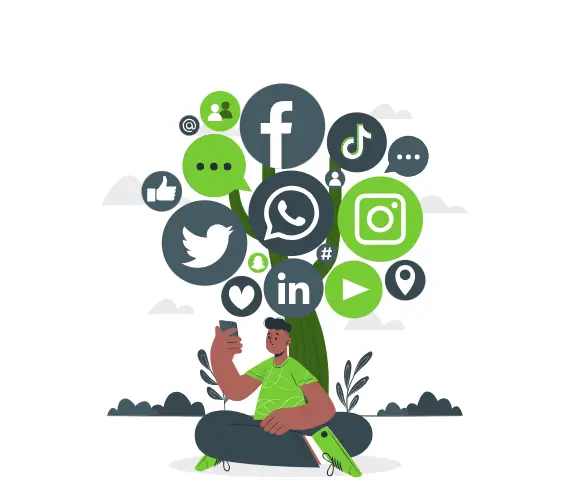Audience
Definition
An Audience is a defined group of people who are most likely to be interested in a particular product, service, or message. These people share common characteristics that make them receptive to the offering.
Description
Picture this: a sea of faces staring at your landing page, each one a potential customer. Not just faces, but minds brimming with desires, needs, and pain points. That’s your marketing audience.
They’re not just passive observers. They’re the reason you craft compelling ads, tailor website copy, and design irresistible offers. They’re the ones who click, convert, and ultimately fuel your business success.
Here’s the marketing lens on “audience”:
- It’s your bullseye, not a broad target: Understanding your ideal customer demographics, interests, and behaviors is crucial for hitting the mark with your marketing efforts.
- Talk, Don’t Yell: Forget the “spray and pray” approach. Your audience craves personalized messages that resonate with their unique concerns and aspirations.
- They’re the data goldmine: Every interaction, from website visits to social media engagement, reveals valuable insights. Use this data to refine your approach and keep them hooked.
- They’re the ultimate ROI boosters: By understanding your audience, you can craft targeted campaigns that deliver higher conversion rates and maximize your marketing spend.
Think of your audience as the characters in your marketing story. Every piece of content, every ad, every campaign should draw them in, make them feel understood, and ultimately lead them down the conversion path.
Why “Audience” Important?
Ever wonder why marketing targets specific people? Here’s why your audience matters!
- Knowing your ideal customer allows you to laser-focus your efforts on groups most likely to resonate with your brand, maximizing impact and ROI.
- Generic messages fall flat. But when you know your audience’s demographics, interests, and pain points, you can craft messages that speak directly to their needs and desires. This builds trust and creates a deeper connection, making them more receptive to your offerings.
- By tailoring your approach based on individual preferences and behaviors, you offer a unique and relevant experience. Imagine sending birthday greetings customized to their favorite hobbies! This personalization boosts engagement and conversions, increasing the chances of them choosing you.
- Your audience provides valuable data goldmines. Analyzing their engagement, website behavior, and feedback offers insights into their preferences and actions. This data fuels informed decision-making and continuous improvement for future campaigns, ensuring they resonate with your target audience.
- Happy customers are your biggest cheerleaders. When you cater to their needs and build trust, they become loyal brand advocates, spreading positive word-of-mouth and organically boosting your reach. This sustainable growth comes from investing in genuine relationships with your audience.
Factors Affecting Defining Audience
Defining your audience isn’t always set in stone. Let us explore some trends that could impact how you target your ideal customers in the future.
The Blurring of Online and Offline: As the lines between physical and digital experiences continue to blur (think augmented reality marketing), audience definitions might need to encompass both online and offline behaviors.
The Power of User-Generated Content (UGC): Consumers increasingly trust recommendations from peers more than traditional advertising. This could lead to audiences being defined by their social circles and the content they engage with.
The Rise of Voice Search and Conversational Marketing: As voice assistants and chatbots become more sophisticated, audience needs might be defined more by spoken language patterns and conversational preferences.
The Evolving Attention Span: With constant bombardment of information, audience attention spans could become even shorter. This will require marketers to define their audiences based on how they consume information in fleeting moments.
Focus on Values and Ethics: Consumers are increasingly aligning their purchases with brands that share their values. Understanding an audience’s ethical stances and social responsibility preferences might become crucial.
How To Define Or Reach Out To Your Audience
1. Know Your Ideal Customer:
- Imagine your perfect customer: their age, interests, what keeps them up at night (their problems).
- Demographics (age, location, income) are a good starting point, but psychographics (interests, values, lifestyles) paint a richer picture.
2. Research, Research, Research:
- Look at your existing customer base – what do they have in common?
- Analyze market research and industry trends to understand your niche.
- Check out your competitors – who are they targeting and how?
3. Craft Buyer Personas:
Create a fictional profile of your ideal customer, giving them a name, a story, and specific needs. This helps visualize your target audience.
4. Don’t Be Afraid to Refine:
Your audience definition isn’t set in stone. As you gather data and feedback, adapt your understanding to better target your ideal customers.
5. Go Where Your Audience Lives:
Identify the platforms and channels your audience frequents (social media, websites, etc.).
6. Speak Their Language:
Tailor your message to resonate with their interests, challenges, and preferred communication style.
7. Listen and Learn:
Pay attention to audience engagement (likes, comments, website visits). This data is gold for refining your approach.
Bonus Tip: Focus on Building Relationships, Not Just Sales:
Provide valuable content, address their pain points, and offer solutions. This fosters trust and loyalty.
Case Study: Patagonia – Targeting the Environmentally Conscious Adventurer
Brand: Patagonia
Target Audience: Environmentally conscious outdoor enthusiasts (aged 25-50, with higher disposable income) who value quality, sustainability, and active lifestyles.
How They Defined Their Audience:
- Demographics: Patagonia considered more than just age and income. They concentrated on psychographics such as a love of nature, participation in outdoor activities (hiking, climbing, etc.), and a willingness to pay more for environmentally friendly products.
- Values and Lifestyle: Patagonia identified a growing consumer segment that values environmental responsibility and activism in addition to their passion for adventure.
- Patagonia actively engages its audience through events, social media, and its Worn Wear program (which promotes used gear repair and reuse). This two-way communication provides useful information about their audience’s needs and values.
How They Reach Their Audience:
- Content Marketing: Patagonia creates high-quality content like films, articles, and social media posts that showcase breathtaking landscapes, environmental issues, and athlete stories. This content resonates with their audience’s love for adventure and activism.
- Cause Marketing: Patagonia actively supports environmental causes and encourages activism among its audience. This aligns with their core values and attracts like-minded customers.
- Experiential Marketing: Patagonia sponsors events and creates experiences like climbing clinics and trail cleanups. This allows them to connect with their audience directly and foster a sense of community.
Results:
- Brand Loyalty: Patagonia enjoys a fiercely loyal customer base who appreciate their commitment to sustainability and activism.
- Premium Pricing Power: By focusing on quality and ethical sourcing, Patagonia commands premium prices that resonate with their target audience.
- Industry Influence: Patagonia has become a leader in the outdoor apparel industry, inspiring other brands to adopt more sustainable practices.
Key Takeaways:
Patagonia’s success stems from their deep understanding of their target audience. They don’t just sell products; they also engage with a community that shares their values. Patagonia has established itself as a brand that its target audience identifies with and passionately supports by offering high-quality, sustainable products, inspiring content, and an activism platform.
FAQs
What is an audience in marketing?
The specific group of people you are trying to reach with your marketing messages and campaigns. Understanding their demographics, interests, needs, and behaviors is crucial for success.
Why is the audience so important in marketing?
Because it allows you to tailor your message, target your outreach, personalize your approach, and ultimately achieve better results. Happy customers become brand advocates, driving further growth.
How do I define my target audience?
Consider demographics, interests, pain points, online behavior, and purchase history. Conduct market research, analyze customer data, and create buyer personas to gain a complete picture.
How can I reach the right audience?
Utilize various marketing channels and platforms catering to your target audience, such as social media advertising, search engine optimization, and content marketing.
How do I craft effective messaging for my audience?
Speak their language, address their pain points, highlight the benefits they care about, and use a tone that resonates with their preferences.
AI Chatbots
Definition
An AI chatbot is a computer program that simulates conversation with human users, using artificial intelligence (AI) and natural language processing (NLP) to understand and respond to their questions and requests.
Description
AI chatbots, using big data and smart algorithms, change how we talk by acting like humans. They’re used everywhere to make customer service better, information easier to get, and save money for businesses. They also answer about 80% of global customer questions, give personalized help, change industries, and will make talking with computers even better in the future.
Here’s the simplified breakdown:
- AI gives it a brain: It can understand what you say and respond in a way that makes sense.
- Natural language processing helps it listen: It doesn’t just understand words, but also the meaning behind them, like jokes or sarcasm.
- Machine learning makes it smarter: Every conversation helps it learn and improve, so it gets better at talking to people over time.
Think of it like this:
- You ask the chatbot a question, like “What’s the weather like today?”
- The chatbot uses its AI and NLP skills to understand your question.
- It then checks its “brain” (a giant database of information) and gives you an answer.
- The more you talk to it, the more it learns about you and how to chat with you in a way you like.
Why are AI chatbots cool?
- They’re always available, 24/7, even when real people aren’t.
- They can answer your questions, even if they’re tricky or specific.
- They can be super helpful, like booking appointments or giving directions.
- They can be fun to talk to and even make you laugh!
How To Use AI Chatbots?
AI chatbots are becoming more common, and interacting with them is usually simple. Here’s an overview of how to use AI chatbots:
1. Identifying a chatbot:
Chatbots are commonly found on websites, mobile apps, and messaging platforms. They can be identified by a chat window or icon, which often includes a name or indicates that you are interacting with a bot.
2. Start a Conversation:
Some chatbots initiate conversations automatically, while others require you to click on the chat window or type a message.
3. Understanding Capabilities.
Chatbots have a variety of functionalities. Some are intended for simple tasks such as answering questions or providing basic customer service. Others may be more sophisticated, handling complex questions or even mimicking natural conversation.
4. Use Keywords and Prompts:
Many chatbots use keywords and prompts to understand your requests. Pay attention to any chatbot-provided instructions or menus. Using relevant keywords or selecting options from a menu will direct the chatbot to assist you.
5. Providing clear instructions:
For best results, make your questions or requests clear and concise. The more specific you are, the better the chatbot will understand your intent and provide an appropriate response.
6. Follow the Instructions:
If it asks you to do something specific (for example, verify your identity or choose from a list of options), follow the instructions to ensure a smooth interaction.
7. Limitations and Human Support:
Although AI chatbots are becoming more advanced, they may not always understand complex requests. If the chatbot is unable to assist you, there may be an option to speak with a human representative for further assistance.
Here are some additional things to remember:
Natural Language Processing (NLP): Some chatbots use NLP to determine the intent of your message, even if you don’t use the exact keywords.
Machine Learning: Advanced chatbots may learn and improve over time based on their interactions with users.
Privacy and Security: Exercise caution when sharing personal information with a chatbot.
How To Build AI Chatbots?
Thinking about making your own chatbot might seem hard because of all the talk about machine learning and artificial intelligence. But don’t worry, it’s not as tough as it sounds! Start by figuring out what you want your chatbot to do, make a plan, and give it the information it needs. Making a chatbot is actually pretty simple. Here’s why:
- No Coding Required – Many chatbot services let you create your own chatbot without needing to know how to code.
- Easy to Connect – Chatbots can work on different apps like WhatsApp, Facebook Messenger, and more.
- Test and Fix – After making your chatbot, you can test it with friends to find and fix any problems before using it widely.
Pros And Cons
Pros –
- Chatbots can provide customer support or answer questions anytime, day or night, offering unparalleled access to information and assistance.
- They can handle multiple inquiries simultaneously, saving businesses time and resources compared to human agents.
- Implementing and maintaining chatbots can be cheaper than employing human customer service representatives, especially for simple inquiries.
- Some chatbots can personalize responses based on user information and preferences, creating a more engaging experience.
- An AI Chatbot can handle high volumes of inquiries quickly and efficiently, reducing wait times and improving customer satisfaction.
- They can collect valuable user data that businesses can use to improve their products, services, and marketing strategies.
Cons –
- While constantly evolving, chatbots may struggle with complex questions or nuanced language, leading to misunderstandings and frustration.
- Unlike humans, chatbots cannot offer emotional support or empathy, which might be crucial in certain customer interactions.
- Technical glitches or downtime can prevent users from accessing needed information or assistance, creating negative experiences.
- Concerns exist about AI chatbots replacing human customer service representatives, potentially impacting employment opportunities.
- Collecting and storing user data through chatbots raises privacy concerns, requiring responsible data protection practices.
- Chatbots trained on biased data may perpetuate discriminatory or offensive responses, highlighting the need for fair and ethical AI development.
How will the future of businesses be expected to change with AI chatbots?
These brainy bots will:
- Serve customers like superheroes by answering questions quickly, recommending products, and handling simple tasks, freeing up human resources for more complex issues.
- Work tirelessly: Chatbots offer 24/7 support, expanding your reach and increasing customer satisfaction.
- Learn and Adapt: Powered by AI, they become smarter over time, better understanding customer needs and responding with personalized responses.
- Make data-driven decisions: Analyze conversations to identify trends and improve customer experiences, resulting in valuable insights.
- Free up resources: AI Chatbot allow you to focus on core business goals while automating tasks, thereby unlocking new growth opportunities.
FAQs
Can AI Chatbot understand complex questions?
Some can handle complex questions, but many still struggle with nuances and require further development.
Can AI Chatbot learn and adapt?
Yes, machine learning allows them to learn from interactions and improve their responses over time.
Do AI Chatbot take away jobs?
Some jobs may be replaced, but they can also create new opportunities in AI development and management.
Marketing Vision
Definition
A marketing vision is a forward-looking statement that describes the long-term aspirations and goals of a company’s marketing department.
Description
A marketing vision helps by providing direction and aligning marketing efforts with business goals while focusing on the customer and improving decision-making. It also inspires creativity and innovation, driving growth and success for the company.

It outlines marketing activities’ strategic direction and objectives, including brand positioning, target audience, messaging, and marketing channels. The marketing vision provides a clear and unified focus for the marketing team and helps to align marketing efforts with the overall business goals and objectives.
Importance of Marketing Vision
A marketing vision is important for several reasons:
- Provides direction: A marketing vision helps define the marketing department’s long-term goals and aspirations, providing a clear direction for the team to follow.
- Aligns with business goals: A marketing vision ensures that the marketing efforts are aligned with the overall business goals and objectives, helping to drive growth and success.
- Focuses on the customer: A marketing vision places the customer at the centre of marketing activities, ensuring that all marketing efforts are focused on meeting the needs and wants of the target audience.
- Improves decision-making: A marketing vision provides a framework for making strategic marketing decisions, helping to prioritise marketing initiatives and allocate resources more effectively.
- Inspires creativity: A marketing vision inspires creativity and innovation, encouraging the marketing team to think outside the box and develop new and exciting ways to reach and engage with customers.
How to create a marketing vision?
To create a marketing vision, you can follow these steps:
- Define your target audience: Identify the customers you want to reach and understand their needs, preferences, and behaviour.
- Analyse the market: Research your competitors, market trends, and opportunities to identify gaps and areas for growth.
- Establish your unique value proposition: Define what sets your company apart from competitors and how you provide value to your target audience.
- Set long-term marketing goals: Define specific, measurable, achievable, relevant, and time-bound (SMART) goals that align with the overall business strategy.
- Develop a positioning statement: Craft a clear and concise statement that communicates your brand’s unique value proposition and differentiation.
- Create a messaging framework: Develop messaging that resonates with your target audience, addresses their pain points, and communicates your brand’s value.
- Identify marketing channels: Determine the most effective channels to reach your target audience and create a comprehensive marketing plan that integrates various channels.
- Communicate the vision: Share the marketing vision with the organisation to ensure everyone is aligned and working towards the same goals.
Example
Nike:
“To bring inspiration and innovation to every athlete* in the world. (*If you have a body, you are an athlete.).”
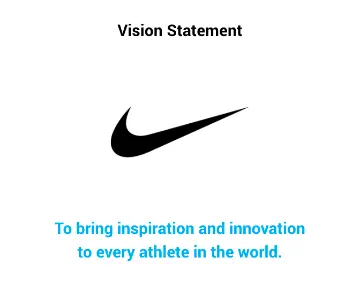
Source:www.google.com
Nike’s marketing vision statement aims to inspire and innovate in sports and fitness. By emphasising their belief that everyone can be an athlete, they aim to connect with a broad audience and empower them to achieve their goals. This statement also reflects Nike’s commitment to innovation and its desire to push the boundaries of what’s possible in sports apparel and equipment. Overall, this marketing vision has helped Nike establish a powerful brand identity and a loyal following of customers who share their passion for fitness and self-improvement.
FAQ
What is a marketing vision?
A marketing vision is a statement that outlines the long-term goals and aspirations of a brand’s marketing efforts. It defines the brand’s purpose, values, and objectives and helps guide strategic decisions related to branding, messaging, and customer engagement.
Why is a marketing vision important?
A marketing vision helps a brand establish a clear direction and purpose for its marketing efforts. It also provides a framework for decision-making and helps align the brand’s marketing strategy with its overall business goals. A well-crafted marketing vision can inspire and motivate employees and stakeholders and help build a strong brand identity and reputation.
How do you create a marketing vision?
To create a marketing vision, a brand should define its purpose, values, and objectives. It should also conduct market research to better understand its target audience and competitive landscape. Based on this information, the brand can craft a statement reflecting its long-term goals and aspirations and inspiring and motivating its stakeholders.
How often should a marketing vision be reviewed?
A marketing vision should be reviewed periodically to remain relevant and aligned with the brand’s current business goals and market conditions. A brand should consider reviewing its marketing vision at least once a year or whenever significant changes to its business strategy, competitive landscape, or target audience exist.
How does a marketing vision differ from a mission statement?
While a marketing vision and a mission statement are important components of a brand’s overall strategy, they serve different purposes. A mission statement outlines the brand’s general purpose and reason for existing, while a marketing vision defines the brand’s long-term goals and aspirations for its marketing efforts. A mission statement is typically more broad and abstract, while a marketing vision is more specific and actionable.
SAAS (Software As A Service)
Definition
SaaS stands for Software as a Service. It is a method in which one can deliver software applications over the internet, usually on a subscription basis.
Understanding SAAS – Software As A Service
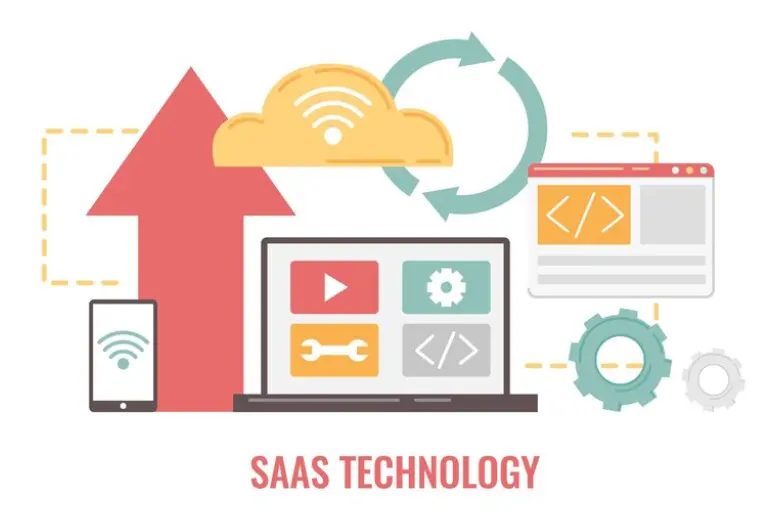
Imagine using powerful software without complex installations or maintenance. That’s the magic of SaaS (Software as a Service). The provider handles everything – operating, managing, and maintaining the software and its infrastructure. You simply sign up, pay a fee, and get started.
While some trace SaaS roots back to the 1950s, the model we know today took off in 1999 with Salesforce’s cloud-based CRM system. Today, it reigns supreme as the leading software delivery method.
Think of all those work tools you use daily. From communication tools like Slack to file sharing with Dropbox, even core business applications like ERP and HR platforms – most are delivered via SaaS.
Why Choose SaaS?
Compared to traditional on-premise software, it offers a multitude of benefits for businesses of all sizes:
- Faster Results: Get up and running quickly with minimal setup time.
- Reduced Costs: Lower upfront costs and predictable ongoing fees compared to traditional software licenses.
- Minimal Maintenance: The provider handles software and infrastructure management, freeing up your IT resources.
It empowers businesses to focus on what they do best, leaving the software headaches to someone else.
Why need SAAS?
For Developers:
- Recurring Revenue: It offers a steady stream of income through subscription fees.
- Faster Deployment: Get your software to users quicker with less need for complex installations.
For Businesses of All Sizes:
It goes beyond disrupting markets; it empowers businesses to:
- Work Anywhere, Anytime: Access software 24/7 from any device with an internet browser.
- Simplify Operations: No need for software installations, hardware updates, or licensing headaches.
- Save Money: Pay-as-you-go models eliminate upfront hardware costs and offer flexible payment options.
- Scale with Ease: Easily adapt your software solution as your needs grow or shrink.
- Secure Your Data: It providers invest heavily in data security infrastructure and expertise.
- Gain Insights: Access data reporting and analytics tools to make informed decisions.
Who Benefits Most From SaaS?
- Startups & Small Businesses: Get up and running quickly without the burden of building or maintaining software.
- Large Enterprises: Utilize SaaS for short-term projects or specialized applications.
- Mobile-First Businesses: Easily manage applications accessible on both web and mobile devices.
How SAAS Works?
It makes use of cloud computing infrastructure and economies of scale to give customers a more efficient way to adopt, use, and pay for software. All SaaS applications share the following characteristics:
It’s applications are designed to be hosted in the cloud. The SaaS software vendor can host the application on its own cloud infrastructure or through a cloud service provider (such as Amazon Web Services (AWS), Google Cloud, IBM Cloud, or Microsoft Azure). Hosting with a reputable cloud service provider allows the SaaS provider to provide the scalability and global accessibility that some customers require.
It’s applications are available to any customer with an internet connection and an internet-connected user device (such as a computer, mobile phone, or tablet). SaaS applications typically run in any web browser; however, on mobile devices, SaaS applications may benefit from (or require) a mobile or tablet app. A few SaaS applications, such as Adobe Acrobat, may offer or require a dedicated thin client, which users must download and install on their computers.
It’s applications use a multi-tenant architecture, which means that each customer is served by a single instance of the application. To ensure security and privacy, each customer’s application data, user data, system data, and custom configurations are kept separate from those of other customers.
Most importantly, SaaS applications require minimal to no management and maintenance.
The SaaS vendor is responsible for –
- Provision, manage, and maintain all servers, networking equipment, storage hardware, and operating software required to run the application.
- Providing feature fixes and security patches as needed.
- Load balancing, redundant infrastructure, data backup, cloud security, and disaster recovery services are provided to prevent outages and meet the service level agreement’s performance, availability, and data protection standards.
Many vendors also offer an application programming interface (API) that customers can use to integrate their SaaS application with other SaaS or traditional software applications.
What are the challenges in using SAAS?
While SaaS provides a huge number of advantages, there are also some challenges you have to consider when adopting this model. Those are:
- Vendor Lock-In: If you have to switch between two SaaS providers, it can become very complex as your data is heavily integrated with that application. You have to carefully plan, as data portability considerations are very important.
- Internet Reliance: You have to have consistent internet connectivity, as it is very crucial for accessing SaaS applications. Disconnection with the internet can disrupt your workflow, it highlights the importance of reliable internet service providers.
- Limited Customization: While some applications offer you customization options, they might not be as considerable as traditional software that you have to install on your own hardware. You have to understand the level of customization offered is essential before choosing a provider.
- Data Security: Since your data resides on the provider’s servers, choosing a reputable SaaS provider with robust security measures is paramount to ensure your data’s safety and privacy.
Canva: Design Democratized with a Cloud-Based Platform
The Challenge:
Creating professional-looking graphic design materials was once an expensive and time-consuming process that necessitated specialized software and design knowledge. Canva aimed to make design accessible to all.
The Solution:
Canva entered the market with a user-friendly, cloud-based design tool. Here’s how SaaS helped them:
- Freemium Model: The free tier provided basic design tools and templates, attracting a large user base. Paid plans provided access to premium features and functionalities.
- Drag-and-Drop Interface: The user-friendly interface made design accessible to those with no prior experience.
- Collaboration Tools: Real-time collaboration features enable teams to work seamlessly on projects.
SaaS Advantages:
Accessibility: SaaS delivery eliminates the need for costly software downloads, making design tools available on any device with an internet connection.
Global Reach: Canva’s cloud-based platform enabled them to reach a global audience without regard for geography.
Scalability: The SaaS model allowed for easy scaling as the user base grew exponentially.
The Outcome:
Canva’s innovative approach, powered by SaaS, revolutionized the design industry:
Massive User Base: Canva has millions of users worldwide, including individuals and large businesses.
Unicorn Status: The company’s valuation has surpassed $30 billion, cementing its status as a design powerhouse.
Key Takeaways:
Canva’s story exemplifies the benefits of SaaS for startups:
- Reaching New Markets: SaaS removes geographical barriers, allowing startups to serve a global audience from day one.
- Empowering Users: SaaS platforms can democratize access to specialized tools and services, resulting in a more inclusive business environment.
- Data-Driven Decisions: SaaS solutions generate valuable user data, allowing for data-driven decisions in product development and marketing strategies.
Canva’s success demonstrates that SaaS can be an effective tool for startups to disrupt existing industries while also empowering users and creating entirely new design paradigms.
You also may like Ultimate Guide to SaaS SEO
FAQs
What is a saas application?
A SaaS application, also known as a “Software as a Service” application, is a type of software program that you access over the internet through a subscription instead of installing it on your own computer.
Here’s a breakdown of the concept:
- Software: It’s still a program that allows you to perform specific tasks, just like traditional software you might install on your computer.
- As a Service: Instead of buying a license and installing it yourself, you access it as an ongoing service through a subscription. Think of it like paying for electricity or water – you use it as needed, and the provider takes care of the infrastructure behind the scenes.
- Cloud-based: The software runs on servers maintained by the provider, typically in large data centers. You access it through a web browser or a dedicated mobile app.
What is saas in cloud computing?
In cloud computing, SaaS (Software as a Service) is a way to deliver software to users over the internet, eliminating the need for local installations and ongoing maintenance.
- Cloud-Based Delivery: The software resides on remote servers managed by the SaaS provider. You access it through a web browser or mobile app.
- Subscription Model: You typically pay a subscription fee to access the software, often on a monthly or yearly basis.
- Reduced IT Burden: The provider handles software updates, security, and maintenance, freeing up your IT resources.
What is IaaS, PaaS and SaaS?
These terms all refer to different ways you can access and use computing resources over the internet, also known as cloud computing.
IaaS (Infrastructure as a Service): It refers to renting the basic building blocks of a computer – servers, storage, networking equipment. With IaaS, you have complete control over these resources and install any software you need. It’s like renting a bare apartment and furnishing it yourself.
PaaS (Platform as a Service): It provides the underlying infrastructure (like IaaS) but also includes a platform for developing and deploying your own applications. You don’t manage the servers or network, but you have more control over the software layer.
SaaS (Software as a Service): This is the most user-friendly option. SaaS provides access to complete software applications over the internet, with no need for installation or maintenance on your end. You simply log in and use the software.
Social Media
Definition
Social media refers to the ways by which individuals connect in virtual communities and networks, creating, sharing, and/or exchanging information and ideas.
Description
Social media is a flexible instrument with numerous applications in modern culture. It allows for quick communication, connecting people worldwide despite geographic constraints.
Its platforms allow for the effective broadcast of information while promoting awareness, education, and involvement on various topics. Social media fosters virtual communities, allowing like-minded people to interact, collaborate, and support one another.
Businesses use social media for marketing, branding, and customer engagement, which increases their reach and visibility. Social media promotes activism and advocacy by amplifying voices for social change. Social media’s utility stems from its potential to establish connections, enable information flow, and stimulate societal change.
Role Social Media for startups or small businesses
The Role of Social Media:
Social media plays a pivotal role in modern society, serving as a multifaceted platform that influences communication, interaction, and information dissemination on a global scale. Its significance extends across various domains, shaping individual behaviours and collective trends.
- Communication Hub: One of the primary roles of social media is to act as a hub for communication. It enables instant messaging, real-time conversations, and asynchronous communication while fostering connections and relationships. It allows people to connect with acquaintances, relatives, coworkers, and communities beyond geographical boundaries, fostering a sense of belonging and community.
- Information Sharing: Social media is an effective tool for sharing and accessing information. Users can exchange news, articles, comments, and personal updates with their networks, rapidly disseminating information and ideas. Social media sites frequently use algorithms to select material based on user preferences, influencing users’ content consumption patterns.
- Community Building: Social media encourages the formation and development of online communities based on shared interests, hobbies, causes, or identities. These communities offer forums for like-minded people to communicate, collaborate, and support one another, resulting in virtual communities that cross geographical boundaries.
- Influence and Opinion Shaping: Social media platforms dramatically impact public Opinion, attitudes, and behaviour. They serve as forums for public discourse, discussion, and advocacy, allowing individuals and organisations to express their views, raise awareness of social concerns, and rally support for causes.
- Marketing and Branding: Social media has become crucial to corporate and organisational marketing and branding strategy. It provides opportunities for targeted advertising, brand promotion, customer involvement, and market research, allowing businesses to reach and connect with their target audience in a personalised and interactive manner.
- Cultural Influence: Social media, a powerful influencer, shapes cultural trends, norms, and behaviours. By amplifying cultural phenomena, viral content, and online movements, it serves as a platform for cultural expression, creativity, and identity formation. It influences popular culture and societal values, making the audience feel more aware and engaged with the world around them.
How to improve social media impact?
Growing business is possible with the rise ins social media impact:
- Use the right tool to optimise content:
Business owners sometimes get too busy to regularly go into social media accounts and provide content. Fortunately, social media management tools such as Buffer and Hootsuite may help automate your social posting, saving you time while maintaining an active presence.
These tools allow you to manage all of your social media accounts in one place, schedule posts weeks in advance, post at optimal times when the majority of people will see them, and track how well your posts are performing.
- Focus on customer service:
Focusing on assisting others is a wonderful strategy to increase your social media presence. Using social media as a customer care platform can drive more traffic to your accounts and make it easier to resolve their difficulties. For example, using Twitter as a customer support channel publicises your service efforts, which can improve your company’s public impression – especially if you do a good job.
- Promote social media account:
Promote your social media presence to your customers and encourage them to engage with you on your accounts. Here are some ways to boost your social media accounts:
- Include social media icons to your website.
- Add your social media feeds to your website’s sidebar.
- Include social media links in your email signature.
- At the end of each blog article, invite readers to follow you on social media.
- Promote your social media profiles with email marketing.
You should also cross-promote your social media accounts on many platforms. Include hashtags and account names in your social media bios to encourage people to engage with you across various platforms.
- Focus on trends
One of the most effective strategies to increase your company’s social media presence is to monitor social media trends and capitalise on popular trends as they emerge. Riding a current trend can increase your visibility to new users and possibly help your postings go viral.
Keep track of what’s trending to stay up to date on trends. For example, on Twitter, the top trending hashtags are displayed on the left side of the homepage in the Trends for You area.
- Focus on eye-catching visuals:
Avoid utilising excessively uninteresting stock photographs. Instead, concentrate on visuals that will resonate with users. Share high-quality behind-the-scenes photos and images of customers using your items. Encourage customers to send in images of themselves interacting with your product – this method also increases social proof and consumer trust.
Trends that can affect social media management
- The rise of ephemeral material, such as Stories on platforms like Instagram, Snapchat, and Facebook, is more than a trend; it represents a substantial shift in social media management strategy. Brands must adapt to and embrace the ephemeral nature of this content format. Creating engaging and authentic material that now connects with consumers is essential to being relevant and interacting with them.
- Directly integrating e-commerce services into social media platforms can be a game-changer for businesses. However, social media managers are pivotal in leveraging these purchasing features, such as Instagram purchasing and Facebook Marketplace. By doing so, they not only enhance the user experience but also significantly boost sales and revenue, thereby elevating the strategic value of their function.
- Algorithm Changes: Social media networks often adjust their algorithms, which affects content visibility and reach. Social media managers must stay updated on algorithm updates and alter their strategy to improve content performance and audience engagement.
- Privacy Concerns and Regulation: Increased regulatory scrutiny, such as GDPR in Europe and the CCPA in California, impacts how social media companies gather and use user data. Social media administrators must emphasise user privacy, follow legislation, and employ clear data procedures to gain and keep their audience’s trust.
Example
Zomato, a popular Indian online meal delivery and restaurant discovery tool, exemplifies how social media may be used to its full potential. The brand curated original content by encouraging consumers to post their eating experiences with #Zomato, which increased trust and trustworthiness.
Zomato efficiently addressed customer issues by engaging with them quickly on media such as Instagram and Twitter, preserving its strong brand image. Innovative marketing campaigns, such as interactive contests and gifts, attracted global attention, increasing brand exposure. Zomato’s programming was tailored to regional tastes, and it connected with a wide range of Indian customers, cementing its position as the competitive food delivery industry leader.
FAQ
What are the uses of social media?
Communication, networking, information sharing, entertainment, and marketing are among the many uses of social media. It allows people and businesses to connect, share content, interact with audiences, and form communities online.
What is the impact of social media?
Social media has a tremendous impact on society by influencing communication patterns, consumer behaviour, public opinion, and cultural trends. It enables rapid information dissemination, amplifies voices, affects perceptions, and fuels social and political movements.
What are some typical social media applications?
Facebook, Twitter, Instagram, LinkedIn, Snapchat, TikTok, Pinterest, and YouTube are among the most popular social networking applications. Each platform has distinct features and functionality that are targeted to specific sorts of content and user interactions.
What is social media management?
Social media management entails monitoring and optimising an organisation’s presence on social media networks. It involves creating content, scheduling postings, engaging audiences, managing communities, tracking analytics, and developing strategies to fulfil marketing and branding goals.
Keyword Research
Definition
Keyword research is the process of researching significant search terms that people use in search engines such as Google and strategically incorporating them into your content so that it ranks higher on a search engine results page (SERP).
Description
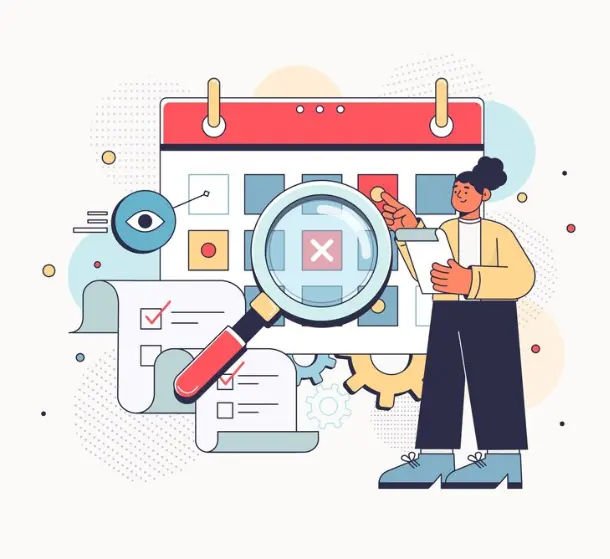
When it comes to content ranking, search engines prioritise well-written material that is relevant to search intent. Keyword density—how frequently you use a keyword in your content—is no longer the most crucial aspect of search engine optimization. Keyword research strategies have and will continue to adapt to the ever-changing search engine algorithms.
Keyword research is typically done early in a campaign and can serve as a foundation for subsequent projects, campaigns, or material. Keyword research can help you brainstorm ideas for new pieces of content, decide how to label product features and optimise your website or web pages after publication.
While keyword research tactics vary from small business to enterprise, we’re here to discuss all types of best practices. This comprehensive strategy improves your capacity to locate the perfect keywords for your audience at the right moment, regardless of your SEO requirements.
Importance of keyword research tools for SEO
- When it comes to content ranking, search engines prioritise well-written material that is relevant to search intent. Keyword density—how frequently you use a keyword in your content—is no longer the most crucial aspect of search engine optimization.
- Keyword research strategies have and will continue to adapt to the ever-changing search engine algorithms.
- Keyword research is typically done early in a campaign and can serve as a foundation for subsequent projects, campaigns, or material. Keyword research can help you brainstorm ideas for new pieces of content, decide how to label product features and optimise your website or web pages after publication.
- While keyword research tactics vary from small business to enterprise, we’re here to discuss all types of best practices. This comprehensive strategy improves your capacity to locate the perfect keywords for your audience at the right moment, regardless of your SEO requirements.
How to find SEO keywords?
- Identify Important Topics: Begin by noting the crucial topics relevant to your niche or industry. These could be broad themes or categories encompassing your content or products/services.
- Keyword Buckets: Once you have identified the essential topics, break them down into specific keyword buckets. These buckets are keywords that revolve around a central theme or topic.
For example, if you have a website about fitness, your keyword buckets could include “weight loss,” “strength training,” “nutrition,” etc.
- Understand User Intent: Establishing the intent behind the keywords you’re targeting is essential. Determine whether users searching for these keywords seek information, products, services, or something else. This insight will allow you to properly adjust your material to your target audience’s needs.
- Research Related Keywords: This is crucial in expanding your keyword list. By researching connected words you can find variations, synonyms, and related terms to your target keywords. Tools such as Google Keyword Planner, SEMrush, and Ahrefs can be utilised for this purpose. This will help you discover additional keywords that might have yet to be initially considered, expanding your keyword list and uncovering potential opportunities.
- Keyword Research Tools: These tools play a significant role in your keyword research process. They help you gather data and insights about the keywords you’ve identified. Valuable data like search volume, competition level, and trends can be acquired. Analysing this data will allow you to prioritise your keyword list and concentrate on the most promising chances for your SEO approach.
How can keyword mapping affect SEO ranking?
Keyword mapping is essential for SEO ranking, ensuring your website’s content is relevant to user search intent and search engine algorithms.
Keyword mapping improves SEO rankings by enhancing relevance, improving user experience, avoiding keyword cannibalization, optimizing internal linking, and optimizing on-page features. Increase the visibility and ranks of your website in search engine results pages (SERPs) by matching its content with targeted keywords and search intent.
Here’s how keyword mapping can affect SEO ranking:
- Relevance: Proper keyword mapping ensures that each page of your website focuses on specific keywords or phrases relevant to the content. When search engines explore your site and discover relevant keywords assigned to each page, they better understand the context and relevancy of your content to user queries. This enhances the possibility that your pages will appear in search results for related queries, thus improving your SEO rating.
- User Experience: Effective keyword mapping improves the user experience by offering information directly addressing visitors’ search queries. When people arrive at a page that fits their search intent, they are likelier to stay on your website longer, interact with your content, and potentially convert. Search engines employ user engagement measures such as bounce rate, time on page, and click-through rate to determine ranks. Therefore, a great user experience can boost your SEO ranking.
- Avoiding Keyword Cannibalization: Keyword mapping helps to avoid keyword cannibalization, which happens when many pages on your website compete for the exact phrase. By mapping keywords to individual pages and ensuring each page targets unique phrases or variations, you prevent diluting your content’s authority and relevance. This clarity indicates which pages to prioritise for specific queries to search engines, resulting in higher rankings for targeted keywords.
- Internal Linking Structure: Keyword mapping can help you plan your internal linking structure and effectively distribute link equity and authority across your website. By linking related pages using suitable anchor text, you may increase the subject relevance of your material while also improving search engine crawlability and indexation. A well-structured internal linking system can enhance your site’s exposure and ranking potential.
- Optimised Metadata: By mapping keywords to specific pages, you can optimise essential on-page elements like titles, meta descriptions, headers, and image alt tags. When these parts include relevant keywords and accurately represent the page’s content, they can increase click-through rates from search results and indicate to search engines that your website is appropriate for specific queries, resulting in higher ranks.
Example
Consider the brand “GreenGrow,” which provides organic gardening equipment online. GreenGrow seeks to attract environmentally concerned clients who are enthusiastic about sustainable gardening approaches. To effectively reach this target group, GreenGrow conducts keyword research to determine the most relevant terms and phrases that potential buyers use while looking for organic gardening supplies.
GreenGrow uses keyword research to identify essential subjects in organic gardening, such as composting, natural pest control, heirloom seeds, and eco-friendly gardening gear. These subjects are then divided into keyword buckets, bringing relevant terms together for more precise targeting.
FAQ
What are keyword research tools for SEO?
Keyword research tools are software platforms or applications that help marketers and website owners uncover relevant keywords and phrases people use when browsing the internet. These tools provide vital information about search volume, competition level, and keyword trends, which can help you design effective SEO tactics.
What are some popular keyword research tools for seo?
- Google Keyword Planner, a free tool from Google, provides insights into search volume and keyword ideas based on their data.
- SEMrush is a comprehensive SEO tool that provides keyword research, competition analysis, and other useful SEO information.
- Ahrefs is well-known for its vast keyword database and backlink analysis capabilities, but it also provides sophisticated keyword research tools.
- Moz Keyword Explorer: As part of the Moz Pro package, this tool offers keyword suggestions, search volume data, and keyword difficulty scores.
- Ubersuggest: Developed by Neil Patel, this tool provides keyword suggestions, content ideas, and competitor analysis capabilities.
How do keyword research tools benefit SEO efforts?
Keyword research tools benefit SEO operations in a variety of ways:
- They provide data-driven insights into user search behaviour, assisting in identifying high-value keywords to target.
- These tools provide competitive analysis, allowing customers to learn about competitors’ keyword rankings and search performance.
- Keyword research tools help decide which keywords to pursue based on search volume and difficulty.
- They help to identify long-tail keywords and related terms that may be used to broaden content and generate more targeted traffic.
Are there any free keyword research tools available?
Yes, free keyword research tools are available, with Google Keyword Planner being the most popular. Other free solutions are Ubersuggest’s basic version and KeywordTool.io. While some tools provide helpful information, their functionality may be limited compared to premium alternatives.
Brand Positioning
Definition
Brand positioning is a marketing phrase that refers to the distinct value that a brand offers its customers.
Description
It is a marketing approach that brands use to define their brand identity while communicating their value proposition, which is why a customer prefers their brand over others.
Brand positioning is employed when a firm wants to position itself in a specific way to their audiences so that customers can form associations between the brand and its value proposition. It is a part of marketing brand strategy
For a brand it is important to create a brand positioning statement.
A brand positioning statement is an internal positioning summary that businesses use to describe and promote the value their brand provides to their target market and customers.
It is intended to express a brand’s value proposition in a concise manner. Typically, brand positioning statements are part of a business’s overall marketing strategy, and they should strike a balance between aspiration and reality.
When developing a brand positioning statement, consider the following:
- Who is the target audience or customer?
- What is your product or service category?
- What is the most significant advantage and impact of your product or service?
- What is the evidence of such benefit and impact?
Importance of positioning in marketing
Brand positioning helps in attracting the correct audience, and effectively communicating your value proposition. Understanding what makes your company distinctive allows you to position your brand in a way that resonates with your target audience, demonstrating why you’re the best option for them and what distinguishes your products or services.
- It allows you to defend your price strategy. The brand’s positioning can be used to support price strategies. In other words, when a product’s price is high due to its quality and rarity, and the brand positioning accentuates these factors, the cost becomes justifiable in the eyes of the client. This also holds true for lower-cost products.
- It boosts your brand’s creativity. Although multiple companies provide products and services that appeal to the same target market and audience, they differ and are distinct according to their brand positioning. That is why proper positioning can make or ruin your brand. Customers will return for more if you use a new, inventive plan and execute it well!
How do you create brand positioning strategy?
Creating a brand positioning strategy involves a series of crucial steps to establish a distinct identity in the minds of your target audience. Let’s elaborate on each point:
- Establish your present brand positioning: Understand your brand’s position in the market. This includes determining how people perceive your brand, their associations with it, and how it compares to competitors.
- Create a brand essence chart. A brand essence chart assists in defining your brand’s essential beliefs, personality, and characteristics. It often comprises the brand’s mission, values, personality attributes, and tone of voice.
- Identify your competition. Determine who your primary competitors are in the market. This covers direct competitors who provide identical products or services and indirect competitors who may meet the exact requirements through various means.
- Conduct competitive research: Analyze your competitors’ strengths and weaknesses. This entails evaluating their positioning strategies, messaging, target audience, product offerings, price, and marketing techniques.
- Determine your unique value proposition: Explain what distinguishes your brand from competitors and why customers should choose your brand over others. Your distinct value proposition should highlight your advantages or solutions that your competitors do not.
- Create a brand positioning structure. Create a foundation for your target audience’s perception of your brand. This includes developing your brand’s positioning statement, core messaging, and strategies.
- Create a positioning statement: Create a succinct statement highlighting your brand’s unique value proposition and market position. This statement should resonate with your target demographic and set your business apart.
- Evaluate if your positioning works: Continuously monitor and evaluate the efficacy of your brand positioning approach. This includes receiving consumer feedback, researching market trends, and measuring brand perception metrics to ensure your positioning is effective with your target demographic.
- Create an emotional connection with prospects and customers. Create messages and brand experiences that elicit strong emotional responses from your consumers. This could include storytelling, visuals, and customer engagement methods that create a deep emotional bond with your brand.
- During the sales process, emphasise your brand’s distinguishing features. Ensure your sales and marketing efforts continually emphasise your brand’s distinct value proposition and distinguishing characteristics. This helps to reinforce your brand positioning and increases the likelihood of conversion.
- Create value. Showcase the value your brand offers customers through its products, services, and brand experience. This includes fulfilling commitments, exceeding customer expectations, and constantly providing high-quality services.
- Ensure that customer-facing staff embody your brand. Train and empower your personnel to represent your company’s values and provide a consistent brand experience to customers. This involves ensuring staff attitude, communication, and actions are consistent with your brand’s positioning and values.
Branding trends that can emerge in 2024
Some of the striking branding trends that can emerge in 2024:
- Personalisation
Personalization has emerged as a critical branding trend in 2024, helping firms stand out and connect with their audiences.
Personalization is more than a trend; it is a strategy that has the potential to revolutionise your brand. By modifying interactions, products, and services to audience preferences, you can stand out in a competitive market and establish a devoted client base. This trend is prevalent in industries such as retail and hospitality, where consumer loyalty is critical to success.
Consider Coca-Cola’s “Share a Coke” campaign, in which the brand attached names on billions of Coke bottles, which led to more than 100 million social media interactions! It increased customer interaction by inspiring thousands to visit stores and see their name on a bottle.
- Colours:
A monochromatic brand colour palette contains various shades of the same colour. You start with a base colour and add different shades through font, images, icons, materials, etc.
Monochromatic colours create a cohesive look for your brand and generate a soothing sense of tranquillity. The primary colour you choose establishes the rest of your brand colour palette. So, choose a colour relevant to your industry and embodies your brand personality.
- Use of illustrations:
In 2024, an increasing number of brands will choose for a holistic, human-like appearance. It creates an instant emotional connection! Consider the use of illustrations by MailChimp.
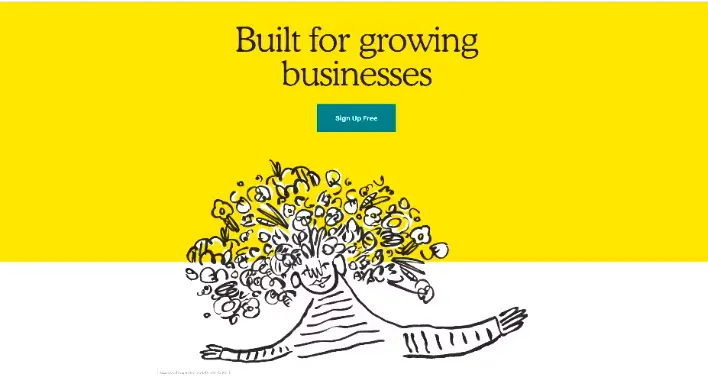
The dynamic, sketchy style evokes a sense of speed, which aligns with the brand’s objective to make email marketing as quick and simple as possible for its consumers.
- Simplify brands
To develop a memorable brand, you can also use a bold font, a vibrant colour scheme, and careful use of negative space are sufficient.

Choose one design element, such as a font or colour palette, and make it memorable!
Fabindia’s brand is distinguished by a colourful and earthy colour palette influenced by Indian culture and history. The brand frequently uses colours like deep indigo, rich maroon, brilliant orange, and earthy tones like olive green and mustard yellow. These hues represent the variety and vibrancy of India’s heritage and craft traditions.
Fabindia’s branding materials feature a mix of traditional and contemporary fonts. The font employed by the company is frequently sophisticated but approachable, expressing a combination of contemporary design and tradition. Fonts are chosen to be easy to read while still complementing the brand’s overall design.
Fabindia has built a distinct brand identity that resonates with consumers in India and around the world by continuously incorporating these features into its products, packaging, marketing materials, and retail spaces.
In 2024, marketers will use simple features that deliver a punch to convey their message. This branding style arose from a desire for simplicity and structure without losing originality.
- Use of multimedia or sonic branding
In 2024, we anticipate to see more brands incorporate multimedia components into their branding.
Forbes defined sonic branding as the strategic use of sound as part of a brand’s identity. This allows marketers to go beyond visual components and elicit emotions, memories, and deeper connections with their customers, all while enhancing brand recall.
What else could be a best example other than Netflix.

One famous example of Netflix’s auditory branding is the iconic startup sound, also known as the “ta-dum” sound. This characteristic sound, created by Hans Zimmer’s studio, acts as Netflix’s audio branding and is played before the start of any original content.
The “ta-dum” sound has become synonymous with Netflix and immediately alerts users that they are about to watch content on the network.
Netflix strengthens its brand identity by using a variety of auditory aspects in its user interface, promotional materials, and marketing initiatives. These may include background music in advertising videos, sound effects in user interfaces, and audio cues tailored to specific content genres or events.
Example
Amul, an iconic Indian brand, has carved itself a niche in the market by promoting itself as “The Taste of India.” With a focus on quality and trust, Amul has become synonymous with dependable dairy products.
Despite its devotion to quality, Amul remains affordable, ensuring that its products are available to a wide spectrum of customers. Amul’s logo reflects its Indian history, incorporating traditional patterns and iconography to reinforce its authenticity. Amul’s brand positioning is also based on innovation, with the company regularly releasing new flavours and marketing through digital media.
FAQ
How do you establish brand positioning?
Brand positioning include defining the brand’s distinct value proposition, determining target audience needs and preferences, analyzing rival positioning, and developing a clear and convincing positioning statement.
What factors should be considered when determining brand positioning?
Consider market research, target audience demographics and psychographics, competitive analysis, brand principles and personality traits, product/service features and benefits, and current market trends.
How do you measure the effectiveness of brand positioning?
Several indicators can be used to assess the efficacy of brand positioning, including brand awareness, brand perception surveys, customer feedback, sales performance, market share, and brand loyalty.
Sales Funnel
What is Sales Funnel
Sales Funnel is a visual representation of the journey your potential customers (prospects) take, from simply being aware of your brand to ultimately becoming a paying customer.
Understanding Sales Funnel
It’s a powerful tool for visualizing the customer journey, from initial awareness to final purchase. Understanding the funnel enables businesses to optimize their marketing and sales efforts, resulting in more conversions and satisfied customers.
To understand this, consider a waterfall. People at the top have yet to see your business. As they descend the falls, they learn more about you. By the end, some of them become satisfied customers who return to your business!
The sales funnel resembles that waterfall. It demonstrates how people go from never hearing about you to becoming customers. Understanding this funnel can help businesses improve their marketing and sales, bringing in more customers and keeping them satisfied!
Types Of Sales Funnel
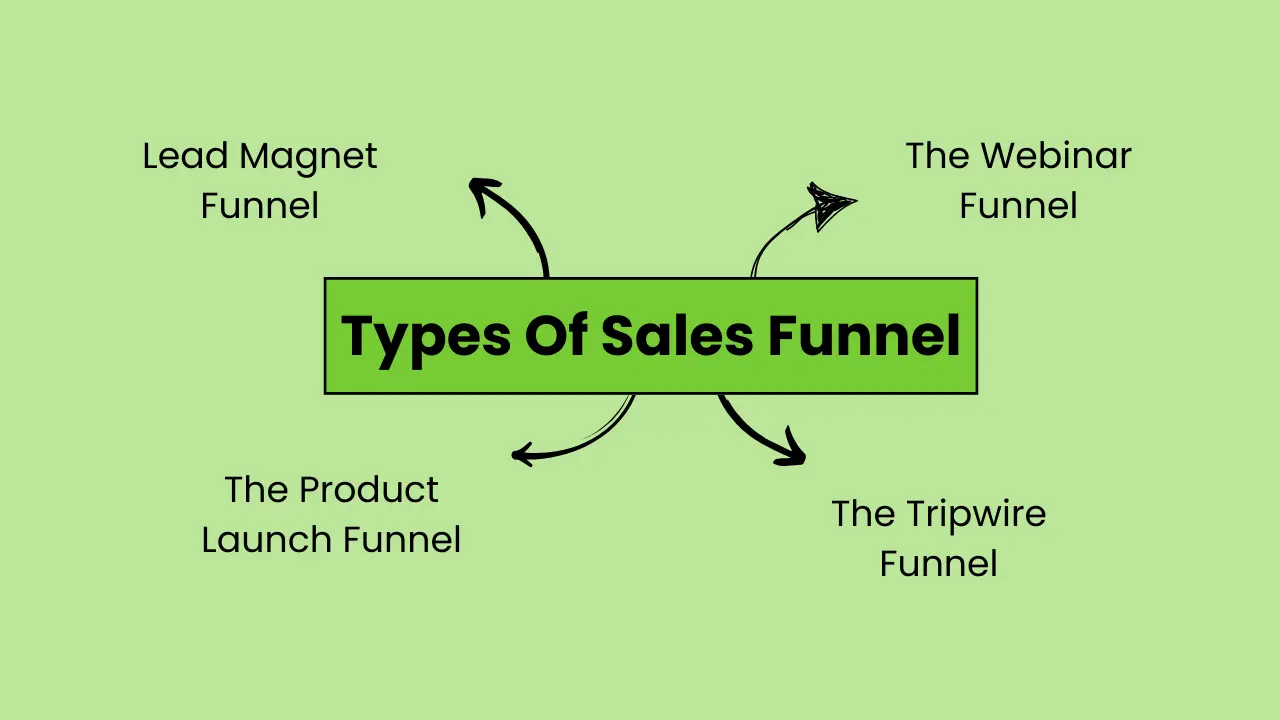
There is no one-size-fits-all approach. So let’s discuss the four main types of sales funnels, each with its own strengths. –
1. Lead Magnet Funnel:
About the funnel: This funnel focuses on attracting potential customers by providing a free offer in exchange for their contact information (typically an email address).
Features include –
- Target the top of the funnel (TOFU) – awareness stage.
- Provides valuable resources such as ebooks, guides, and webinars.
- Creates an email list to nurture leads further down the funnel.
Assume you sell fitness programs. You could offer a free “7-Day Beginner’s Workout Guide” in exchange for an email address. This enables you to nurture leads with additional fitness tips before eventually promoting your paid workout programs.
2. The Webinar Funnel:
About the funnel: This funnel focuses on hosting informative webinars to educate potential customers and demonstrate your expertise.
Features:
- Targets the MOFU (consideration stage) – nurturing leads.
- Provides useful content to increase trust and establish thought leadership.
- Captures registrations with email addresses for future communication.
For example, an accounting software company might host a webinar titled “Top Tax Tips for Small Businesses.” Attendees would need to register with their email address so that the company could follow up with free software trials or demos.
3. The Product Launch Funnel:
About the funnel: This funnel generates excitement and anticipation for a new product launch.
Features:
- Creates a sense of urgency and exclusivity for upcoming products.
- Uses email marketing, social media campaigns, and limited-time offers.
- Captures pre-orders or early access registrations to build initial sales momentum.
For example, a clothing brand may use social media teasers and email campaigns to announce a limited-edition clothing line. This heightens anticipation, encouraging customers to pre-order the new collection before it sells out.
4. The Tripwire Funnel:
The funnel features a low-cost introductory product to entice potential customers.
Features include –
- Targeting the BOFU (decision stage) and conversion stage.
- Offers a low-risk way for customers to experience the value proposition.
- The goal is to convert them into paying customers for higher-priced products later.
For example, a company that sells productivity software may offer a discounted introductory month on their basic plan. Once the customer has experienced the value, they may be more likely to upgrade to a premium plan with additional features.
Sales Funnel Examples
So, now we know what a sales funnel is and what its types are, let us understand it in more detail with the help of some interesting examples.
Example 1: Fitness Tracker Company
![]()
Imagine you’re a company selling fitness trackers. Here’s how your sales funnel might look:
Top of the Funnel (TOFU): This is where you create awareness and attract potential customers who might be interested in getting fit or improving their health. You might:
- Run social media ads showcasing people using your fitness tracker and achieving their fitness goals.
- Create blog posts on topics like “Top 10 Fitness Tips for Beginners” or “How to Track Your Sleep for Better Health.”
- Partner with fitness influencers to promote your tracker on their channels.
Middle of the Funnel (MOFU): Here, you nurture leads who are now aware of your fitness tracker and might be considering buying one. You might:
- Offer a free downloadable guide on “Creating a Personalized Fitness Plan.” This requires an email signup, allowing you to capture leads.
- Host a free webinar on “Maximizing Your Workouts with Fitness Trackers.” Attendees would register with their email, providing valuable contact information.
- Send targeted email campaigns with educational content on using fitness trackers and success stories from satisfied customers.
Bottom of the Funnel (BOFU): This is where you convert leads into paying customers. You might:
- Offer a discount on your fitness tracker for a limited time.
- Highlight customer testimonials on your website showcasing the positive impact of your product.
- Run retargeting ads on social media to remind website visitors who viewed your products but didn’t purchase yet.
Example 2: Online Language Learning Platform
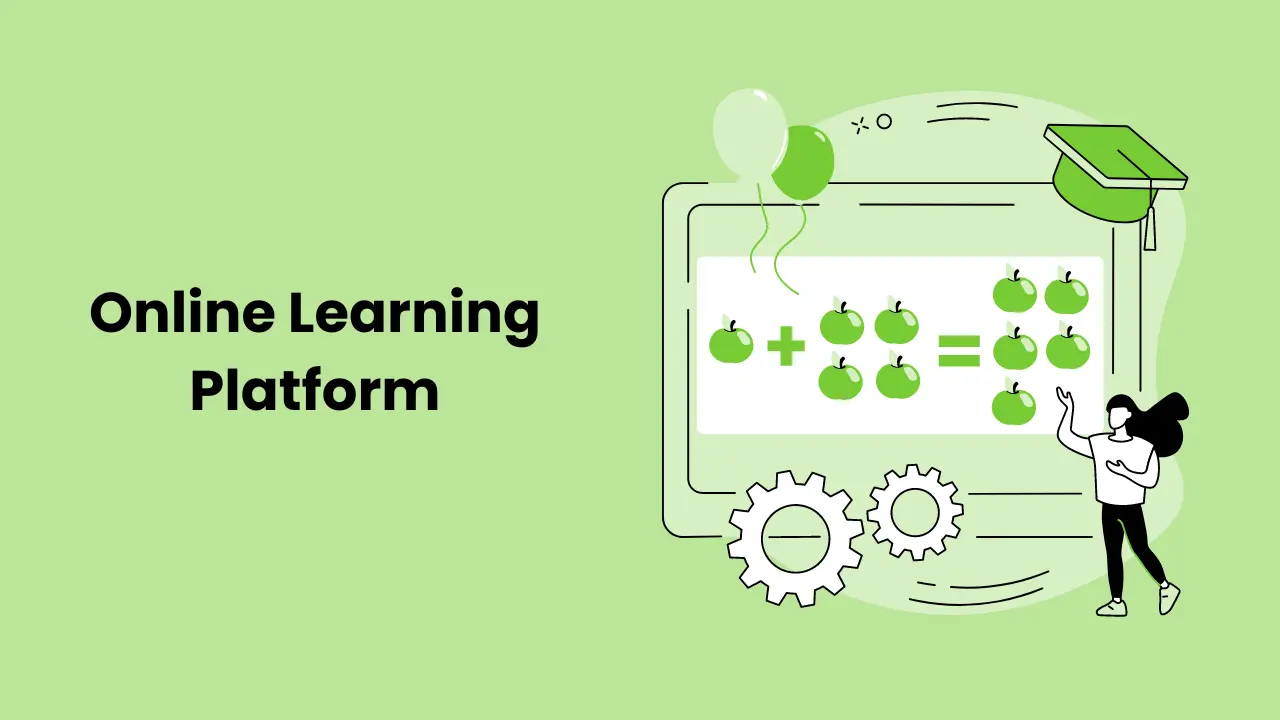
Let’s say you run an online platform for learning a new language. Here’s a possible structure for your funnel:
TOFU: Attract people interested in learning a language but unsure where to start. You might:
- Develop a free online language quiz to assess someone’s current language level.
- Create informative YouTube videos on language learning tips and cultural insights.
- Run social media campaigns with engaging content showcasing the benefits of learning a new language.
MOFU: Nurture leads who are actively considering learning and might be evaluating different platforms. You might:
- Offer a free trial of your online language learning platform, allowing users to experience some features before committing.
- Host live Q&A sessions with language experts to address common questions and showcase your platform’s value.
- Send personalized email sequences based on user interests, offering relevant language learning resources and success stories.
BOFU: Convert leads into paying subscribers. You might:
- Highlight different subscription plans catering to various learning needs and budgets.
- Offer bonus materials like downloadable vocabulary lists or interactive exercises for paid subscribers.
- Provide time-limited promotions on annual subscriptions or bundled learning packages.
Tools For Sales Funnel
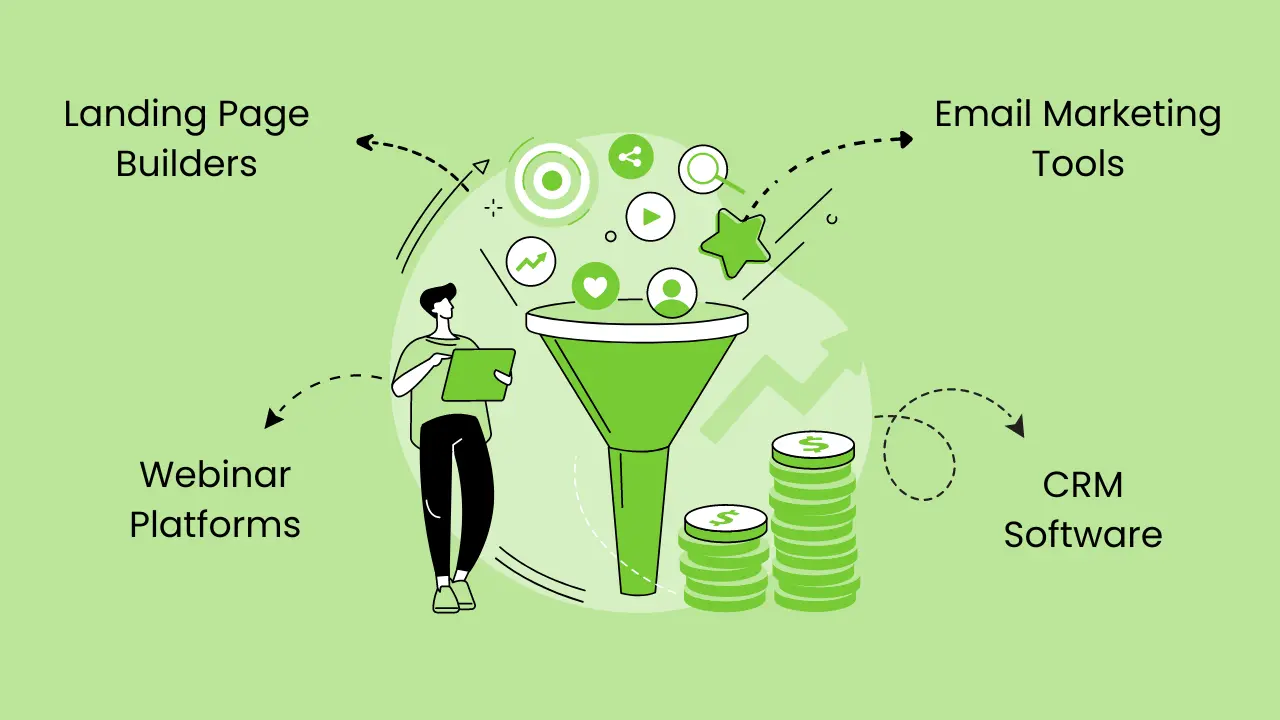
Building effective sales funnels requires the right tools. Here are some useful options that businesses or marketers could prefer:
1. Landing Page Builders (TOFU & MOFU):
Landing page builders allow you to create high-converting landing pages specifically designed to capture leads or promote specific offers.
Features: Drag-and-drop interface, pre-built templates, analytics integration, lead capture forms, A/B testing capabilities.
How it helps: Businesses and marketers can easily create targeted landing pages for each stage of the funnel, maximizing conversions and lead generation.
Popular options include:
- Leadpages: User-friendly platform with strong lead capture features (Free trial, Paid plans start at $25/month).
- Unbounce: Conversion-focused builder with A/B testing and pop-up creation (Free trial, Paid plans start at $80/month).
- ClickFunnels: All-in-one solution with landing page builder, email marketing, and sales pipeline management (Free trial, Paid plans start at $97/month).
2. Email Marketing Tools (MOFU & BOFU):
Email marketing tools help you manage email lists, create and send targeted email campaigns, and track campaign performance.
Features: Email automation workflows, segmentation capabilities, email template library, analytics and reporting dashboards.
How it helps: Businesses and marketers can nurture leads with relevant email sequences, promote offers, and convert leads into paying customers.
Popular options include:
- Mailchimp: Great for beginners with a free plan for limited contacts (Free plan, Paid plans start at $11/month).
- Constant Contact: Reliable platform with strong automation features and deliverability rates (Free trial, Paid plans start at $20/month).
- ActiveCampaign: Advanced automation capabilities for complex nurture sequences and segmentation (Free trial, Paid plans start at $15/month).
3. Webinar Platforms (MOFU):
Webinar platforms facilitate hosting live online presentations and engaging with your audience.
Features: Screen sharing, video conferencing, audience engagement tools like polls and Q&A, registration management.
How it helps: Businesses and marketers can host informative webinars to educate potential customers, showcase expertise, and generate leads through registrations.
Popular options include:
- GoToWebinar: Established platform with a robust feature set for large webinars (Free trial, Paid plans start at $89/month).
- Zoom Webinars: User-friendly and scalable solution for webinars of all sizes (Free plan for up to 100 participants, Paid plans start at $14/month per host).
- WebinarJam: Interactive platform with built-in marketing automation features (Free trial, Paid plans start at $47/month).
4. CRM Software (BOFU):
CRM (Customer Relationship Management) software helps manage customer interactions, track leads, and streamline sales processes.
Features: Contact management, deal pipeline tracking, sales task automation, reporting and analytics.
How it helps: Businesses and marketers can manage leads and customer relationships more effectively, improve sales team performance, and close more deals.
Popular options include:
- HubSpot CRM: Free plan with basic features, paid plans offer advanced sales automation tools (Free plan, Paid plans start at $45/month).
- Salesforce Essentials: Feature-rich CRM platform for managing leads, opportunities, and customer data (Free trial, Paid plans start at $25/month per user).
- Zoho CRM: Affordable CRM solution with a wide range of features and integrations (Free plan for up to 3 users, Paid plans start at $12/month per user).
Techniques For Sales Funnel
Sales funnel techniques are specific strategies you can implement within each stage of the sales funnel (TOFU – Top of Funnel, MOFU – Middle of Funnel, BOFU – Bottom of Funnel) to improve lead generation, nurture prospects, and ultimately convert them into paying customers.
How Do They Work?
By employing a variety of techniques within each funnel stage, you can create a seamless and engaging customer journey. These techniques address the specific needs and motivations of potential customers at each stage, moving them steadily towards a purchase decision.
Example Techniques for Each Stage:
- TOFU (Awareness & Education):
- Content Marketing: Create informative blog posts, articles, or infographics that address common pain points and establish your brand as a thought leader.
- Social Media Marketing: Run targeted social media campaigns to raise brand awareness and engage potential customers with relevant content.
- Search Engine Optimization (SEO): Optimize your website content with relevant keywords to improve organic search ranking and attract qualified leads.
Imagine: You sell fitness trackers. A TOFU technique could be creating a blog post on “5 Simple Habits to Develop a Healthy Lifestyle.” This attracts potential customers interested in fitness and positions your brand as a source of valuable information.
2. MOFU (Consideration & Nurturing):
- Lead Magnets: Offer free downloadable resources like ebooks, whitepapers, or webinars in exchange for email addresses.
- Email Marketing: Develop targeted email sequences that provide valuable content, address specific needs, and nurture leads towards a buying decision.
- Retargeting Ads: Show targeted ads to website visitors who haven’t converted yet, reminding them about your products or services.
Example: In the MOFU stage, you might offer a free downloadable guide on “Choosing the Right Fitness Tracker for Your Needs.” This educates potential customers, builds trust, and captures their email addresses for further nurturing.
3. BOFU (Decision & Conversion):
- Compelling CTAs (Call to Action): Use clear and persuasive CTAs on your website and landing pages to encourage conversions (e.g., “Buy Now,” “Start Your Free Trial”).
- Limited-Time Offers: Create a sense of urgency with limited-time discounts, promotions, or early-bird access to incentivize immediate purchase.
- Customer Testimonials & Social Proof: Showcase positive customer reviews, testimonials, and case studies to build trust and address potential buying hesitations.
In the BOFU stage for your fitness tracker: You could offer a discount code for a limited time, highlight customer testimonials about how your tracker helped them achieve their fitness goals, and showcase a strong call-to-action button like “Buy Now and Get Started on Your Fitness Journey Today!”
If you implement these techniques strategically within your sales funnel, you can guide potential customers on a smooth journey from initial awareness to loyal brand advocacy. Experiment, track results, and refine your approach to create a sales funnel that effectively converts leads into paying customers.
Dollar Shave Club: A Winning Example of the Sales Funnel in Action
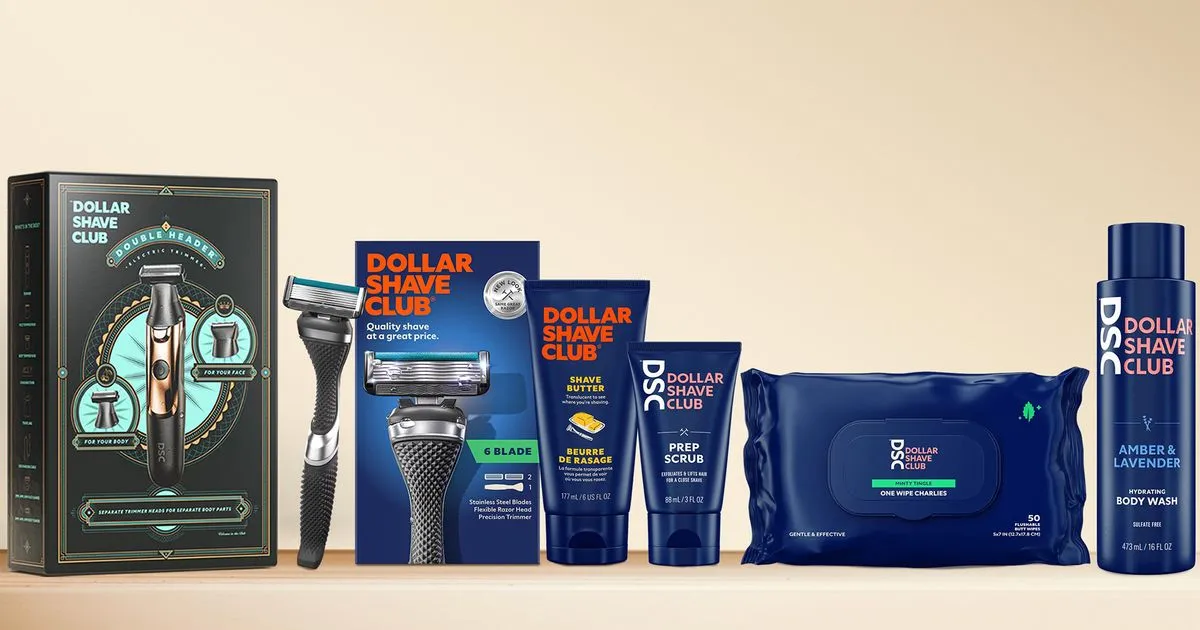
Source: Unilever
Dollar Shave Club (DSC) is a prime example of a brand that skyrocketed to success thanks to a well-defined and optimized sales funnel. Here’s how they leveraged the funnel concept to disrupt the traditional razor market:
TOFU (Awareness & Education):
- Viral Marketing Video: DSC launched with a now-iconic, humorous video on YouTube titled “Our Blades Are F*cking Great.” This edgy and attention-grabbing video went viral, generating massive brand awareness and challenging the perception of expensive, overhyped razors.
- Social Media Engagement: DSC actively engaged with viewers on social media platforms, capitalizing on the video’s momentum and building a community around their brand.
MOFU (Consideration & Nurturing):
- Subscription Model: DSC offered a convenient subscription model, delivering high-quality razors directly to customers’ doorsteps at a lower cost than traditional options.
- Free Trial: They incentivized first-time purchases with a low-cost trial offer, allowing customers to experience the product before committing to a full subscription.
- Informative Content: DSC provided informative content on their website and social media channels, addressing common shaving concerns and highlighting the benefits of their razors.
BOFU (Decision & Conversion):
- Simple & Secure Checkout: The checkout process was streamlined and secure, encouraging customers to complete their purchase with ease.
- Referral Program: DSC implemented a referral program, rewarding existing customers with incentives for recommending the brand to friends and family.
- Subscription Management: Customers could easily manage their subscriptions online, adjust delivery frequency, or cancel at any time, reducing purchase commitment concerns.
Benefits Achieved:
By implementing a strategic sales funnel, Dollar Shave Club achieved remarkable results:
- Disrupted the Market: The brand challenged the dominance of established razor companies by offering a more affordable and convenient solution.
- Rapid Growth: DSC experienced explosive subscriber growth, demonstrating the effectiveness of their sales funnel approach.
- Customer Loyalty: Their subscription model fostered long-term relationships with customers, providing a steady revenue stream.
Conclusion
The sales funnel is a strategic framework that depicts the entire customer journey, from initial brand awareness to final purchase. Businesses can effectively guide potential customers to conversion by understanding the various stages (TOFU, MOFU, and BOFU) and implementing relevant tools and techniques.
We looked at different types of sales funnels, each with its own set of benefits, and how tools like landing page builders, email marketing platforms, and CRM software can help streamline the process. Furthermore, real-world examples such as Dollar Shave Club demonstrated the transformative impact that a well-defined sales funnel can have on a company’s success.
By adopting the sales funnel concept and constantly refining your approach, you can create a smooth and engaging customer journey that converts leads into loyal brand advocates.
Conversion Rate Optimization (CRO)
What Is CRO?
Conversion rate optimization (CRO) is the process of improving the percentage of website visitors who take a desired action, such as making a purchase, signing up for a newsletter, or filling out a contact form. In essence, it’s about turning website visitors into website conversion rates.
Description
Imagine a bustling bakery filled with the delectable aroma of fresh pastries. Customers happily choose their favorites from the displays, perhaps drawn in by the sight of mouthwatering cookies or enticed by the aroma of hot croissants. In the competitive world of online baking, your website can function as a digital bakery, and Conversion Rate Optimization (CRO) is the art of attracting and converting digital customers.
- Conversion: The desired action you want visitors to take, like buying a pastry from the site, subscribing to your newsletter, or booking an online meeting(think sign-ups, purchases, downloads).
- Rate: The percentage of visitors who actually do that action.
Higher rate = more success, but also lower conversion cost!
- Optimization: Tweaking your bakery (website) to make that action more likely. It’s like rearranging displays, offering samples, and having friendly staff (clear CTAs, engaging content, smooth user experience). By optimizing your website, you can not only increase your conversion rate but also potentially reduce your conversion cost by making your marketing efforts more efficient.
Importance Of CRO
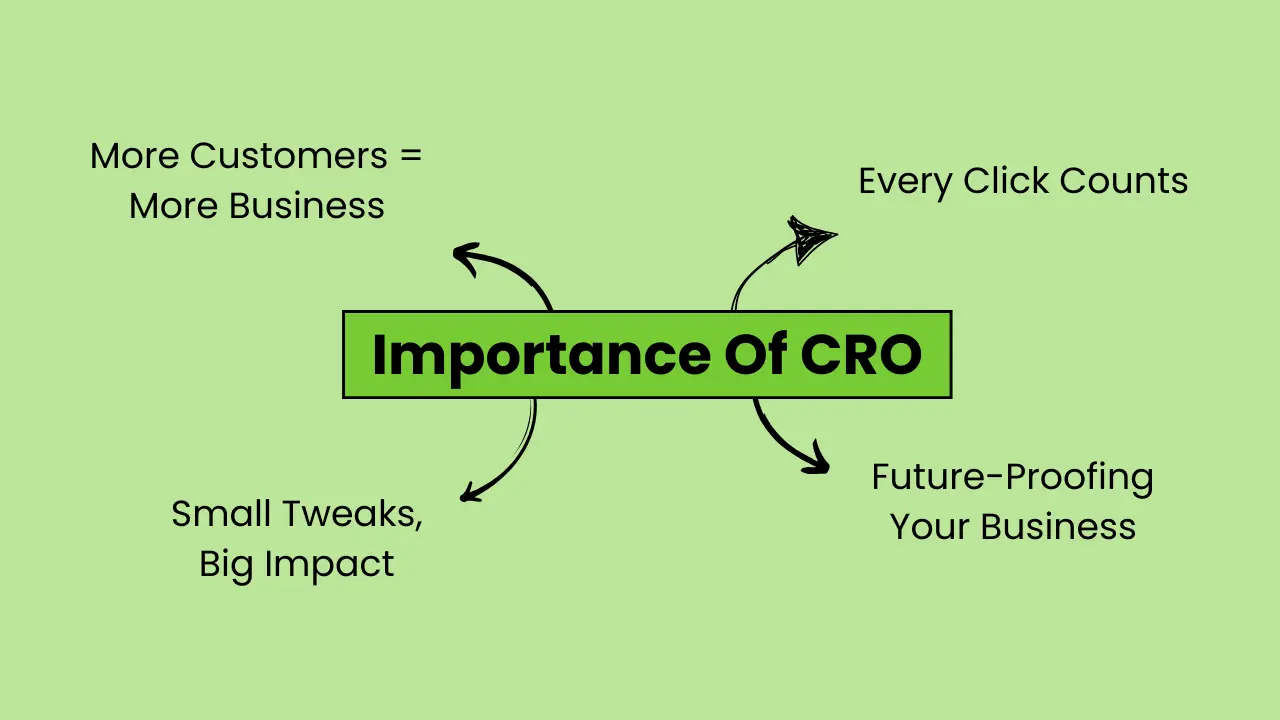
Let’s discuss how Conversion Rate Optimization (CRO) can supercharge your business –
- More Customers = More Business:
Think of every website visitor as a potential customer. With CRO, you’re making it easier for them to find what they need and take action, whether it’s buying something, signing up for your email list, or downloading a brochure.
More actions = more customers = more success!
- Every Click Counts: It costs money to get people to your website, so you want to make sure they don’t just wander around and leave. CRO helps you understand what visitors are doing and why they’re not taking the desired action. By fixing those roadblocks, you turn more lookers into happy customers, all without spending more on advertising.
- Small Tweaks, Big Impact: You don’t need a complete website overhaul to see results. CRO often involves small changes, like clearer buttons, better product descriptions, or faster loading times. These seemingly minor adjustments can make a huge difference in how people interact with your site and ultimately boost your bottom line.
- Future-Proofing Your Business: The online world is constantly evolving, and what works today might not work tomorrow. CRO helps you stay ahead of the curve by understanding how people use your website and making sure it’s always optimized for success.
5 Best Conversion Rate Optimization Tools
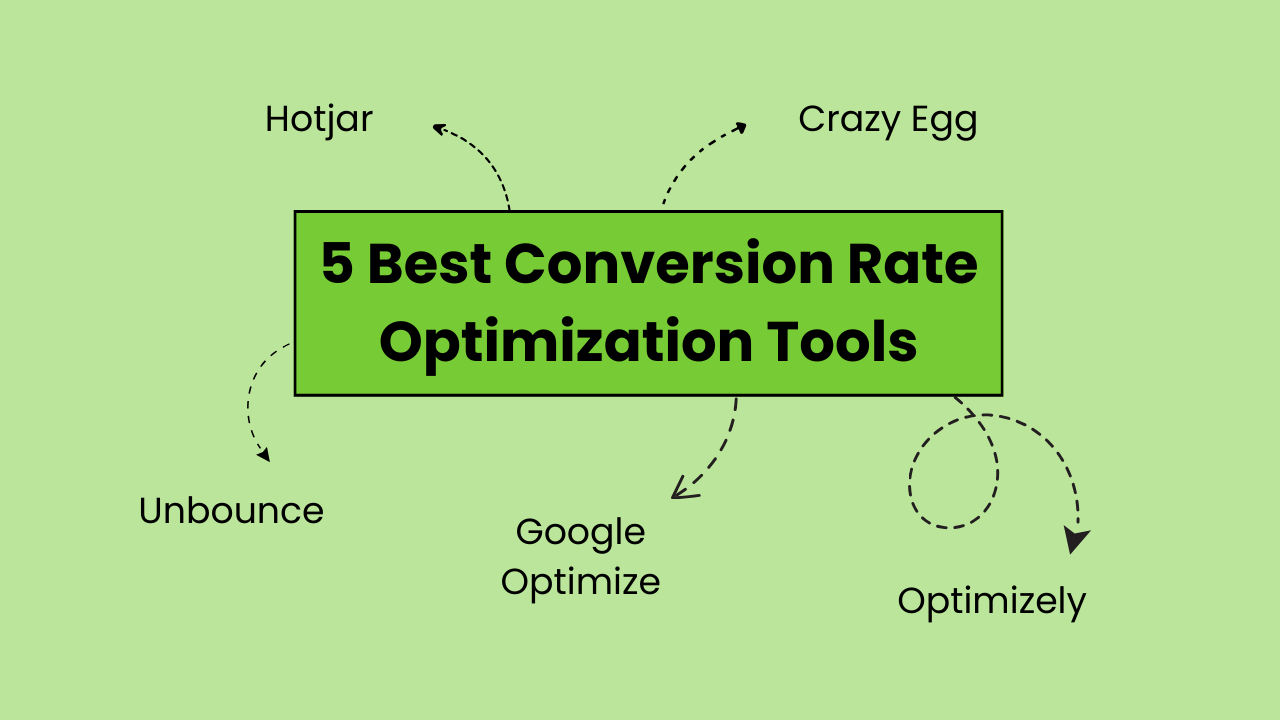
Here are 5 of the best conversion rate optimization (CRO) tools to help you understand your visitors, optimize their experience, and drive more conversions.
1. Hotjar:
Description: An all-in-one CRO platform offering various tools to understand user behavior.
Features:
- Heatmaps: Visualize where users click, scroll, and move their mouse.
- Session recordings: Watch actual user sessions to see how they interact with your site.
- Surveys & polls: Gather user feedback directly on your website.
- Funnels: Analyze how users navigate through specific conversion paths.
Pricing: Freemium model with limited features. Paid plans start at $31/month for basic features, with higher tiers offering additional features and usage limits.
2. Crazy Egg:
Description: Focuses on heatmaps and user recordings for analyzing user behavior.
Features:
- Multiple heatmap options (click, scroll, movement) to understand user engagement.
- Session recordings with filters to analyze specific user segments.
- A/B testing to compare different versions of your website elements.
Pricing: Freemium model with limited features. Paid plans start at $24/month for basic features, with higher tiers offering additional features and session recordings.
3. Optimizely:
Description: A comprehensive platform offering A/B testing, personalization, and feature experimentation capabilities.
Features:
- A/B testing for various website elements like headlines, buttons, and product listings.
- A personalization engine is used to tailor website content and offers based on user behavior.
- Feature experimentation to test and roll out new website features.
Pricing: Custom quote required based on specific needs and usage.
4. Google Optimize:
Description: A free CRO tool by Google, offering basic A/B testing and personalization features.
Features:
- A/B testing for headlines, images, and layouts.
- Personalization based on user attributes and browsing behavior.
- Easy integration with other Google products like Google Analytics.
Pricing: Free to use.
5. Unbounce:
Description: A landing page builder with built-in A/B testing and conversion tracking features.
Features:
- Drag-and-drop landing page builder to create high-converting landing pages.
- A/B testing for different landing page variations.
- Built-in conversion tracking to measure the effectiveness of your landing pages.
Pricing: Plans start at $80/month, offering a limited number of landing pages and A/B tests. Higher tiers offer more features and increased limits.
Pros And Cons
| Pros | Cons |
| The primary benefit of CRO is turning more website visitors into paying customers or leads. By optimizing your website and user experience, you make it easier for people to take the desired action. | Implementing CRO effectively requires time, effort, and potentially specialized skills. You might need to invest in tools, training, or external expertise. |
| Attracting new visitors costs money. CRO helps you maximize the value of your existing traffic, converting more visitors without needing to spend more on advertising. | CRO is an ongoing process, not a one-time solution. As user behavior and trends change, you need to continually monitor and adapt your strategies. |
| CRO isn’t just about sales; it’s about making your website enjoyable and easy to use. By understanding user behavior and addressing pain points, you create a positive experience that keeps people coming back. | Seeing results from CRO takes time and patience. Testing different approaches and analyzing data takes effort, and it might not always deliver immediate results. |
| Implementing CRO involves testing and analyzing user behavior, providing valuable insights into what works and what doesn’t. This data helps you make informed decisions about your website and marketing strategy. | Implementing changes without proper testing can sometimes have the opposite effect, decreasing conversions instead of increasing them. Careful planning and data-driven decisions are crucial. |
| A well-optimized website with a smooth user experience reflects positively on your brand. Visitors perceive you as professional, trustworthy, and easy to do business with. | For certain advanced CRO techniques, some technical knowledge or collaboration with developers might be necessary. |
How To Set Up CRO For Success?
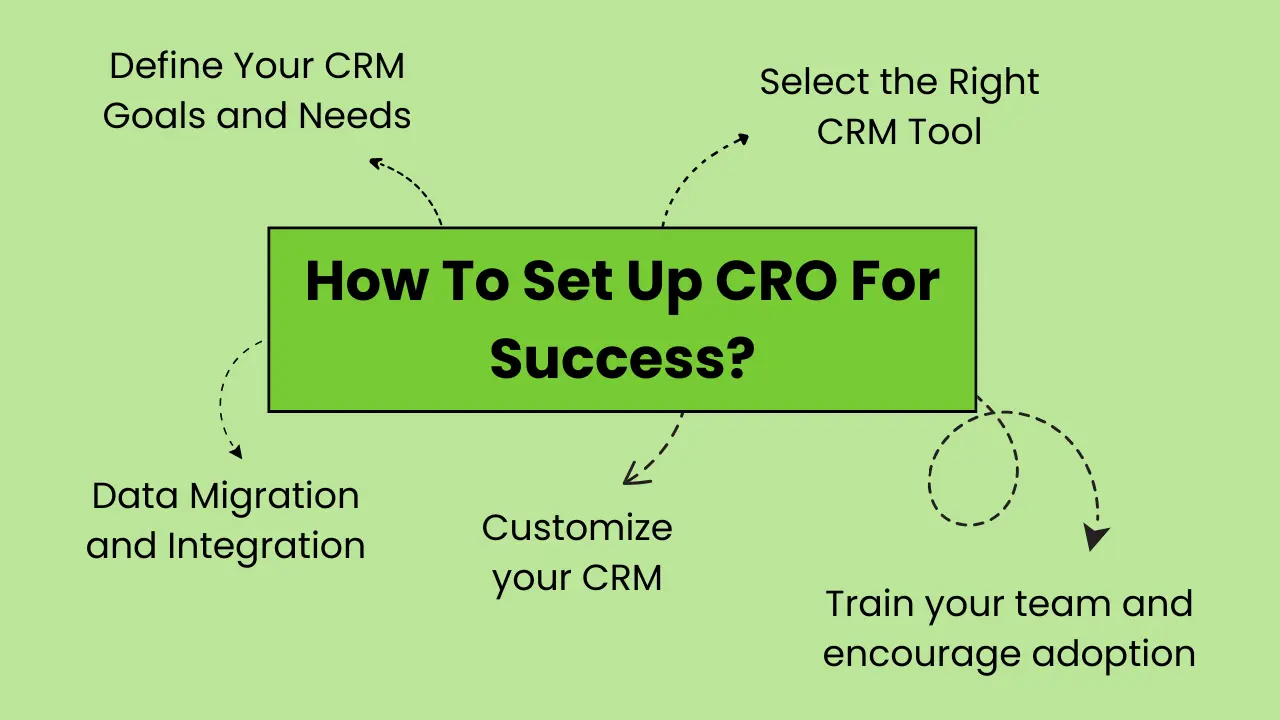
1. Define Your CRM Goals and Needs.
Identify Objectives: What do you hope to accomplish with your CRM? Is it to improve lead generation, increase sales conversions, improve customer service, or simplify communication? Having clear goals helps you determine which CRM functionalities you require.
Understand User Needs: Who will use the CRM in your organization (sales, marketing, or customer service)? Consider their needs and workflows to ensure that the CRM is user-friendly and effectively implemented.
2. Select the Right CRM Tool:
Explore the various CRM solutions available, taking into account budget, features, scalability, and integration with existing tools. Salesforce, HubSpot, Zoho CRM, and Freshworks CRM are some popular options.
Free Trials: Many CRM platforms offer free trials. Utilize them to test drive the features and see if they meet your specific needs and user preferences.
3. Data Migration and Integration.
Import Existing Data: If you have existing customer information, transfer it to your CRM. Ensure that all data is properly cleaned and formatted for optimal system performance.
Integrations: Consider connecting your CRM to other essential tools such as marketing automation platforms, email marketing tools, or accounting software. This improves data flow and automates processes.
4. Customize your CRM.
Customize Fields: Most CRMs allow you to tailor data fields to your specific business requirements. This ensures that you collect the most relevant data about your leads and customers.
Workflow Automation: Investigate the possibility of creating automated workflows within the CRM. This can automate tasks such as sending follow-up emails, assigning leads, and triggering notifications in response to specific actions.
5. Train your team and encourage adoption:
Comprehensive Training: Give your team proper training on how to use the CRM effectively. This includes understanding the system’s features, data entry, reporting, and best practices.
Ongoing Support: Provide ongoing support to answer questions and resolve any issues your team may encounter while using the CRM. Encourage open communication and feedback to increase user adoption.
6. Manage and optimize your CRM:
Regular Data Cleaning: Clean and update your CRM data on a regular basis to ensure accuracy and prevent information from becoming outdated. This is critical for accurate reporting and successful marketing/sales efforts.
Performance Monitoring: Track key metrics like lead generation rates, conversion rates, and customer satisfaction to measure the success of your CRM implementation. Use this data to identify areas for improvement and optimize your CRM setup.
Warby Parker: Streamlining the Online Glasses Shopping Experience

Source: Global Marketing Professor
Warby Parker, the innovative online retailer revolutionizing the eyewear industry, is a prime example of a brand that benefited significantly from conversion rate optimisation services.
The Challenge:
Traditionally, buying glasses involved visiting an optician, getting an eye exam, and browsing a limited selection of often expensive frames. Warby Parker aimed to disrupt this model by offering trendy, affordable glasses online. However, their initial website faced challenges in converting visitors into paying customers.
The CRO Solution:
Warby Parker partnered with a CRO agency to identify areas for improvement. Here are some potential tactics they might have implemented:
- Heatmaps and User Recordings: Understanding how visitors interacted with the website helped identify pain points. For instance, were they struggling to navigate the virtual try-on feature?
- A/B Testing: Testing different versions of product pages, checkout processes, and calls to action (CTAs) could reveal which elements resonated most with customers and led to higher purchase rates.
- Personalization: Recommending glasses based on browsing history or facial features could create a more engaging and personalized shopping experience.
The Results:
By implementing these CRO strategies, Warby Parker likely saw a significant increase in their conversion rate. This could translate to:
- More online glasses sales: A smoother buying process with fewer obstacles might encourage more visitors to complete their purchases.
- Reduced customer acquisition costs: Increased conversion rates mean spending less to acquire new customers.
- Improved brand perception: A user-friendly and efficient online experience can build trust and brand loyalty.
The Takeaway:
Warby Parker’s success story demonstrates the power of CRO services. By partnering with CRO experts, businesses can gain valuable insights into user behavior and optimize their websites to drive conversions and achieve their marketing goals.
Brands Recognized for Innovation in CRO
Unbounce: This company provides a landing page builder that is specifically tailored for conversion optimization. Their success story demonstrates the effect of well-designed landing pages on conversion rates.
Crazy Egg, a popular CRO tool provider, uses heatmaps and user recordings to optimize their website for lead generation and product sales.
Optimizely: Optimizely is a leader in A/B testing and experimentation platforms, and their website demonstrates how effective CRO practices can be for a company that provides CRO solutions.
FAQs
How do I get started with CRO?
Define your goals and target audience, audit your website and identify areas for improvement, prioritize your optimizations, implement and test changes, analyze results and iterate.
What are some common CRO tactics?
A/B testing, website copy optimization, call to action (CTA) improvement, product page optimization, checkout process optimization, mobile website optimization, and personalization.
How much can I expect to increase my conversion rate?
Again, it depends on your website and your specific goals, but even small increases can have a significant impact on your bottom line.
How can I improve conversion rates?
To improve your conversions, take care of these points –
- Boost conversions by making it easier for visitors to take action!
- A/B test elements like CTAs and page layouts.
- Offer clear value propositions and streamline checkout processes.
- Consider using tools like heatmaps to understand user behavior and identify areas for improvement.

